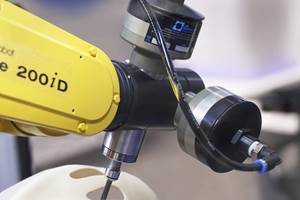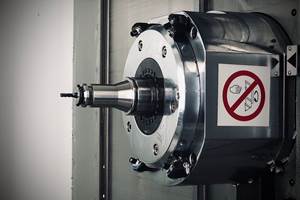Marine Supplier Meets Tricky Tolerances With Presetter And Measuring Machine
For its supercharged six-cylinder Verado outboard motor range, Mercury Marine (Fond du Lac, Wisconsin) set and met multiple new tolerances. One of the trickier tooling tolerances had to do with the valve seat boring tools. The company's Mazak machining centers incorporate 15 of these long, narrow, multi-insert tools to finish machine the 24-valve seats, intake and exhaust in the one-piece aluminum cylinder head. Because valve clearances are factory-adjusted and are designed to remain within tolerance for several thousand hours, close machining tolerances are essential.
Share





For its supercharged six-cylinder Verado outboard motor range, Mercury Marine (Fond du Lac, Wisconsin) set and met multiple new tolerances. One of the trickier tooling tolerances had to do with the valve seat boring tools. The company’s Mazak machining centers incorporate 15 of these long, narrow, multi-insert tools to finish machine the 24-valve seats, intake and exhaust in the one-piece aluminum cylinder head. Because valve clearances are factory-adjusted and are designed to remain within tolerance for several thousand hours, close machining tolerances are essential.
Although the company faced a tall order, it was able to achieve faster turnaround times while improving accuracy. Mercury succeeded by implementing an automatic, three-axis CNC vertical tool presetter and measuring machine.
‚ÄúWith the help of our Venturion system from Zoller Inc. (Ann Arbor, Michigan), we were able to improve tool accuracy from ¬Ī0.0002 inch to ¬Ī2 microns,‚ÄĚ says Dale Kutchek, group leader/preset.
The company says that it previously spent a considerable amount of time setting the tool. ‚ÄúSetting each tool required between half an hour to 45 minutes because we had to calculate all of the settings manually,‚ÄĚ Mr. Kutchek notes. ‚ÄúThis has been reduced to 5 to 10 minutes. We‚Äôve also gained the assurance of consistency.‚ÄĚ
Three separate inserts are positioned in the tool. The way they flow into one another is crucial, as the cutter rotates in the cut and creates the valve seats in the heads for the new engine. The new system can measure the location of each insert on the tool and display the width of the intersection between the three inserts. Therefore, plant personnel know that they will be cutting to a certain depth and diameter on the valve seat. According to Mr. Kutchek, this has directly impacted the cutting accuracy of the machining centers.
Another time-consuming task the company was able to streamline was checking the valve seat tools. This manual process produced less than reliable results. In the hopes of gaining better control, Mercury selected Zoller’s Saturn vision system for automatic measuring and inspection of each tool in the plant’s complement. The company began using the vision system in tandem with the Venturion.
The measuring machine features a Z-axis measuring range of 23.58 inches (600 mm) and diameter of 15.72 inches (400 mm). Two CNC-driven linear slides‚ÄĒvertical and horizontal‚ÄĒposition the optic carrier, while the CNC spindle rotation permits focusing on the tool.
‚ÄúThe image processing technology we employ permits fully automatic measurement of tool length, diameter, corner radius and two cutting edge angles,‚ÄĚ explains Mr. Kutchek. ‚ÄúThe software also detects cutting edges for virtually any shape, location and orientation in the measuring screen.
‚ÄúA manual measuring mode for length, radius and angles helps determine the dimensions of chips and breaks on cutting edges,‚ÄĚ he adds.
Included in the presetter is a high-precision spindle system with power-operated tool clamping for taper, HSK, KM and Capto style tooling adapters. According to Mr. Kutchek, using this system has enabled his group to quickly handle any tool in the plant. Adapters can be exchanged in less than 10 seconds with 1-micron change-over repeatability in length and diameter, as well as 2-micron concentricity.
Once the tool is located in the spindle, the CNC autofocus spindle then provides user-independent and fully automatic tool positioning. The manufacturer offers various focus modes to accommodate any style of cutting edge ge­ometry.
Zoller software measures the cutting contour when rotating the cutting edge through the camera system. As Mercury has found, this capability is useful when measuring the cut­ting contour of milling cutters and form tools to ensure proper machining results prior to cutting one piece. The company postulates that the improvement in first-pass yield at the motor maker is directly related to this capability.
Mercury has also found the valve seat measuring program from Zoller to be particularly valuable in machining the heads for the new four-stroke outboard motors. The Verado supercharger force feeds the combustion chamber with a dense air-fuel mixture, causing high pressure in the cylinders.
In addition to the measuring software, Zoller Tool Management software provides the company with information regarding usage, storage and ordering. Mercury can also manage tool assemblies with graphic information, geometry data and specific machine control data and generate tool lists for production jobs.
More than 6,700 tools are in the tool department’s databases, with two to five back-up tools each. A total of 35,000 tools are accessible in-house. The department sets each one and returns it right back to the shop floor where it is needed. The tools are not stored in a tool crib.
‚ÄúAs we explore the capability of the Zoller system, we‚Äôve also noticed improvements on other tools,‚ÄĚ comments Mr. Kutchek. ‚ÄúThere is more we will learn about what the system can do for us, so we anticipate even greater benefits to our operations. For example, an upcoming boring tool will be electronically set as we add functions to the presetter. Instead of manually adjusting this boring tool, we will work from an interactive display. This lets us relay the appropriate tool setting to the presetter.‚ÄĚ
Related Content
How to Accelerate Robotic Deburring & Automated Material Removal
Pairing automation with air-driven motors that push cutting tool speeds up to 65,000 RPM with no duty cycle can dramatically improve throughput and improve finishing.
Read MoreShoulder Milling Cuts Racing Part's Cycle Time By Over 50%
Pairing a shoulder mill with a five-axis machine has cut costs and cycle times for one of TTI Machine’s parts, enabling it to support a niche racing community.
Read MoreHow to Troubleshoot Issues With Tool Life
Diagnosing when a tool is failing is important because it sets an expectation and a benchmark for improvements. Finding out why gives us a clue for how to fix it.
Read MoreQuick-Change Tool Heads Reduce Setup on Swiss-Type Turning Centers
This new quick-change tooling system enables shops to get more production from their Swiss turning centers through reduced tool setup time and matches the performance of a solid tool.
Read MoreRead Next
AMRs Are Moving Into Manufacturing: 4 Considerations for Implementation
AMRs can provide a flexible, easy-to-use automation platform so long as manufacturers choose a suitable task and prepare their facilities.
Read MoreMachine Shop MBA
Making Chips and 91 ”∆ĶÕÝ’ĺőŘ are teaming up for a new podcast series called Machine Shop MBA—designed to help manufacturers measure their success against the industry’s best. Through the lens of the Top Shops benchmarking program, the series explores the KPIs that set high-performing shops apart, from machine utilization and first-pass yield to employee engagement and revenue per employee.
Read MoreLast Chance! 2025 Top Shops Benchmarking Survey Still Open Through April 30
Don’t miss out! 91 ”∆ĶÕÝ’ĺőŘ's Top Shops Benchmarking Survey is still open — but not for long. This is your last chance to a receive free, customized benchmarking report that includes actionable feedback across several shopfloor and business metrics.
Read More






















